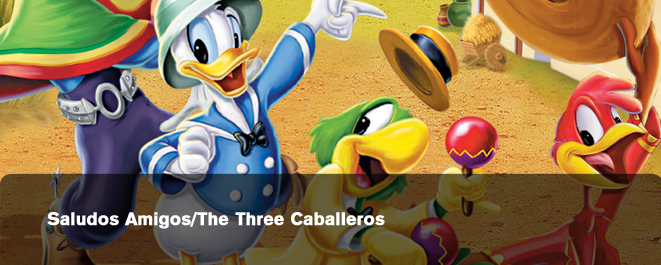|
"Saludos
Amigos" (1942) and "The Three Caballeros" (1945) represent a trying time in
Disney's animation history. The studio was in the middle of World War II
churning out propaganda films for the United States, a strike by animators
which seemed to change the moral at the studio during "Amigos." By 1945, the
studio was trying to get back into the swing of making animated movies, but
with budgets tight, Walt had his animation staff cut some corners. He was
also invited down to South America and the Latin American countries to
promote goodwill to our neighbors. The result is a pair of cartoon
compilations with a loose story thread. The result is also trying on the
viewer, even to die hard Disney fans.
It's been a while since I first popped in the VHS version of "Saludos" and
"Caballeros." Honesty, I never really cared for the films. The segments are
random and go from comedy to artistic and never feel cohesive. These are
movies made during Disney's 1940s period that just don't gel. Some of the
segments, as I recall, have been cut from the film and shown by themselves
on the old "Wonderful World of Disney" television series. I also seem to
recall seeing some of the segments in Spanish class when schools had 16mm
projectors. (Wow, now I'm feeling old!)
"Saludos" has three cartoon segments worth watching. Donald Duck's visit to
Lake Titicaca is every bit as good as his best cartoon shorts. Pedro, the
little airplane "that could" is a gentle and cute film in itself. And
Goofy's adventures as a gaucho has funny moments. The final cartoon,
"Watercolor of Brazil" is a struggle to watch. It's basically a lot of
limited animation of Jose Carioca and Donald Duck singing and dancing. The
rest of the movie is interspersed with 16mm travelogue footage of Walt and
his animators, and life in South America.
"Caballeros" is a little bit more refined and has more going for it. But
it's tough to sit through. I've always liked the segment of "Aves Raras
(Strange Birds)" in which a penguin wants to leave the South Pole for warmer
weather. I was annoyed by the animated character of the aracuan bird. He
annoyed me on VHS and he annoys me on DVD! That repetitive song he sings
just won't get out of my head, and probably won't get out of yours, either.
The story of Little Gauchito and his burro is sweet and comical. The next
segment, "Baia," is what I equate to going to your grandmother's house and
listening to old time music on a phonograph. You can appreciate it, but it
doesn't mean you like it. Aurora Miranda shows up in live action to sing and
dance with Donald Duck and Jose Carioca. The animation and live action blend
is as good as any Disney film that's done it. But I couldn't get past the
music. No, it's not bad, but it's not my cup of tea. The final act of the
movie involves Panchito from Mexico, who shows Donald and Jose his country.
The duo of Latin American Disney movies features some of the most eclectic
animation from the studio since "Fantasia," which was made a few years
before. The films were very popular in their time, especially in Latin
America. But to watch them today takes a bit of patience.
Bill Kallay
Special thanks to Click Communications
Photos: © Disney. All rights reserved.
|
 |
|
DVD
Quick Glimpse |
|
|
MOVIE
Some of it's good, some of it's not so good
TALENT
Directors: Bill Roberts, Jack Kinney, Hamilton Luske, Wilfred
Jackson/Clyde Geronimi, Jack Kinney, Bill Roberts
Cast: Clarence
Nash, Jose Oliveira, Pinto Colvig/Aurora Miranda, Carmen Molina,
Sterling Holloway
FEATURES
Lots of extras
RATING
G
DVD
Picture:
Very Good
Sound: Very Good
GEEK OUT
For real die
hard Disney fans, there's a bit o' Walt to see
TECH SPECS
Aspect
Ratio (1.33:1)
Dolby Digital 2.0
DVD RELEASE DATE
April 29, 2008
|
3 |
|
|

